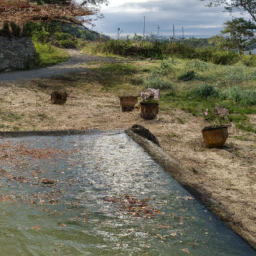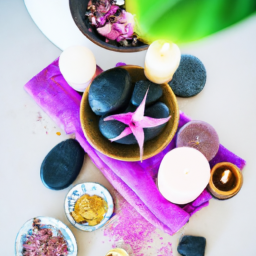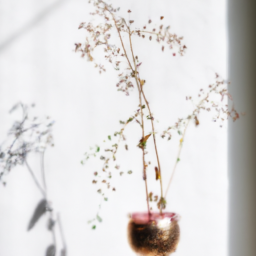
Wellness retreats have become increasingly popular in recent years as people seek to escape the stresses of everyday life and prioritize their mental and physical well-being. These retreats offer a range of activities and amenities designed to promote relaxation and rejuvenation, but one aspect that often goes overlooked is the importance of creating spa-like indoor spaces. In this blog post, we will explore the key elements of designing a wellness retreat that embodies tranquility and serenity, focusing on how to create spa-like indoor spaces that enhance the overall experience for guests. Whether you are a retreat owner or simply someone looking to create a peaceful oasis in your own home, this guide will provide you with practical tips and inspiration to transform any space into a sanctuary of wellness. So, let’s dive in and discover the secrets to crafting inviting and rejuvenating environments that will leave you feeling refreshed and revitalized.
Importance of Design and Layout in Wellness Retreats: Creating Spa-Like Indoor Spaces
Welcome to the world of wellness retreats, where creating spa-like indoor spaces is essential for providing a rejuvenating experience to guests. The design and layout of these spaces play a crucial role in enhancing relaxation, promoting wellness, and creating a serene ambiance. In this article, we will explore the importance of design and layout in wellness retreats and provide you with a step-by-step guide on how to create a spa-like indoor space that will leave your guests feeling refreshed and revitalized.
Creating a Calming Atmosphere
The first step in creating a spa-like indoor space is to establish a calming atmosphere. This can be achieved through careful selection of colors, lighting, and décor elements. Choose soothing colors like soft blues, greens, and neutrals to create a sense of tranquility. Avoid loud or vibrant colors that may disrupt the peaceful ambiance. Lighting is another crucial aspect to consider. Use soft, warm lighting to create a cozy and inviting atmosphere. Incorporate natural light whenever possible, as it has a calming effect on the mind and body.
In terms of décor, opt for minimalism and simplicity. Clutter-free spaces promote relaxation and allow guests to focus on their well-being. Use natural materials like wood, stone, and bamboo to bring a sense of nature indoors. Integrate plants and greenery to enhance the connection with the natural world. The overall goal is to create a space that feels like a sanctuary, where guests can escape from the stresses of daily life and immerse themselves in a state of relaxation.
Additionally, consider incorporating elements of aromatherapy into your design. Scented candles, essential oil diffusers, or natural fragrances can further enhance the calming atmosphere and provide a multi-sensory experience for your guests.
Optimizing Layout for Functionality and Flow
Once you have established a calming atmosphere, it is important to optimize the layout of your wellness retreat for functionality and flow. Guests should be able to navigate the space easily and access different amenities without feeling overwhelmed or confused. Consider the following factors when designing the layout:
1. Reception Area: The reception area is the first point of contact for guests, so it should be warm and welcoming. Provide comfortable seating, soft lighting, and soothing music to create a positive first impression. Ensure that the reception area is easily accessible and clearly marked.
2. Treatment Rooms: Treatment rooms should be designed to provide privacy and tranquility. Opt for soundproofing and adequate insulation to minimize external noise. Use comfortable furnishings and soft lighting to create a cozy and relaxing environment. Consider incorporating elements like heated massage tables, soothing music, and adjustable temperature controls to enhance the overall experience.
3. Relaxation Areas: Relaxation areas are spaces where guests can unwind before or after treatments. These areas should be comfortable and inviting. Provide plush seating, soft blankets, and ambient lighting to encourage relaxation. Consider incorporating features like water fountains, indoor gardens, or meditation corners to further enhance the serenity of the space.
4. Bathrooms and Changing Areas: Bathrooms and changing areas should be clean, well-maintained, and easily accessible. Provide ample storage space, comfortable seating, and adequate lighting. Consider incorporating luxurious amenities like rainfall showers, heated floors, or aromatherapy products to elevate the guest experience.
Creating Personalized Experiences
Lastly, to truly create a spa-like indoor space, it is essential to focus on personalized experiences for your guests. Every individual has unique preferences and needs when it comes to wellness. Consider offering a variety of treatments, such as massages, facials, yoga classes, or meditation sessions, to cater to different interests. Create a menu of services that allows guests to customize their experience based on their preferences.
Furthermore, pay attention to small details that can make a big difference. Provide luxurious robes, slippers, and towels for guests to use during their visit. Offer a selection of herbal teas, infused water, or healthy snacks to promote hydration and nourishment. Personalize the ambiance by allowing guests to choose their preferred music or aromatherapy scents during treatments.
By focusing on personalized experiences, you can ensure that each guest feels valued and cared for, enhancing their overall wellness journey.
In conclusion, the design and layout of wellness retreats play a vital role in creating spa-like indoor spaces. By creating a calming atmosphere, optimizing the layout for functionality and flow, and focusing on personalized experiences, you can provide guests with a rejuvenating and memorable wellness retreat. Remember, the goal is to create a sanctuary where guests can escape from the outside world and immerse themselves in a state of relaxation and well-being. So, start designing your spa-like indoor space today and embark on a journey of wellness and tranquility.

Incorporating Natural Elements and Biophilic Design in Wellness Retreats
Welcome to our guide on creating spa-like indoor spaces in wellness retreats. In this article, we will explore the concept of incorporating natural elements and biophilic design to enhance the overall wellness experience. By bringing the outdoors inside, we can create a serene and rejuvenating environment that promotes relaxation and tranquility.
The Benefits of Natural Elements
Natural elements play a crucial role in creating a spa-like atmosphere in wellness retreats. They have a calming effect on our senses and help us reconnect with nature, which is essential for our overall well-being. Here are some key benefits of incorporating natural elements:
1. Stress Reduction: Natural elements, such as plants, water features, and natural materials, have been proven to reduce stress levels. They create a soothing environment that promotes relaxation and helps us unwind.
2. Improved Air Quality: Indoor plants not only add a touch of greenery but also help purify the air by removing toxins and releasing oxygen. This improves the overall air quality in the space, making it healthier for guests.
3. Enhanced Mood: Being surrounded by natural elements has a positive impact on our mood and mental well-being. It can help reduce anxiety, depression, and fatigue, and promote feelings of happiness and contentment.
Biophilic Design Principles
Biophilic design is an approach that seeks to connect people with nature through the built environment. By incorporating biophilic design principles, we can create spaces that mimic natural environments and evoke a sense of calm and tranquility. Here are some key principles to consider:
1. Natural Light: Maximizing natural light is essential in creating a spa-like indoor space. Large windows, skylights, and light-colored walls can help bring in ample sunlight, creating a bright and airy atmosphere.
2. Use of Natural Materials: Incorporating natural materials, such as wood, stone, and bamboo, adds a touch of nature to the space. These materials not only look visually appealing but also provide a tactile experience for guests.
3. Indoor Plants and Greenery: Adding plants and greenery to the indoor space is a simple yet effective way to incorporate natural elements. Plants not only improve air quality but also create a sense of tranquility and harmony.
Creating a Biophilic Retreat Space
Now that we understand the benefits of natural elements and the principles of biophilic design, let’s explore how to create a biophilic retreat space:
1. Choose a Nature-Inspired Color Palette: Opt for earthy tones, such as greens, browns, and blues, to create a calming and serene environment. These colors mimic natural landscapes and evoke a sense of tranquility.
2. Incorporate Water Features: Water features, such as indoor fountains or small ponds, can add a sense of serenity and relaxation to the space. The sound of flowing water creates a soothing ambiance and helps guests unwind.
3. Create Natural Dividers: Instead of using traditional walls or partitions, consider using natural dividers like bamboo screens or living walls. These not only add a touch of nature but also create a sense of privacy without completely closing off the space.
4. Provide Comfortable Seating: Choose comfortable seating options, such as plush chairs or cozy floor cushions, to create a space where guests can relax and unwind. Incorporate natural materials like rattan or hemp for an added touch of nature.
5. Incorporate Nature-Inspired Artwork: Hang nature-inspired artwork, such as landscapes or botanical prints, to bring the beauty of the outdoors inside. These pieces can serve as focal points and add visual interest to the space.
6. Create a Sensory Experience: Consider incorporating aromatherapy diffusers or scented candles to enhance the sensory experience. Choose natural scents like lavender or eucalyptus to promote relaxation and rejuvenation.
By following these steps and incorporating natural elements and biophilic design principles, you can create a spa-like indoor space in your wellness retreat. Remember, the goal is to provide guests with an environment that promotes relaxation, rejuvenation, and a deep connection with nature.

Enhancing Relaxation and Serenity through Lighting and Color Schemes in Wellness Retreats
Welcome to the world of wellness retreats, where relaxation and serenity take center stage. In this article, we will explore how lighting and color schemes can play a crucial role in creating spa-like indoor spaces that promote a sense of calm and rejuvenation. By carefully considering these elements, you can transform your wellness retreat into a haven of tranquility.
The Power of Lighting
When it comes to creating a spa-like atmosphere, lighting is key. The right lighting can instantly set the mood and create a sense of relaxation. Here are some tips to enhance the ambience of your wellness retreat:
1. Natural Light: Incorporating natural light into your indoor space can have a profound impact on the overall atmosphere. Large windows, skylights, and glass doors allow sunlight to flood in, creating a bright and airy environment. Natural light not only improves the aesthetic appeal but also has numerous health benefits, such as boosting mood and increasing vitamin D levels.
2. Dimmers: Installing dimmer switches for your artificial lighting allows you to adjust the intensity according to the desired mood. Soft, warm lighting in the evenings can create a cozy and intimate atmosphere, while brighter lights during the day can promote alertness and productivity.
3. Task Lighting: In addition to ambient lighting, incorporating task lighting is essential. Task lighting provides focused illumination for specific activities such as reading, writing, or practicing yoga. Adjustable desk lamps, floor lamps, and wall-mounted lights can be strategically placed to cater to individual needs.
The Influence of Color Schemes
Color has a profound impact on our emotions and can significantly influence our mood. When designing your wellness retreat, consider the following color schemes to create a serene and inviting atmosphere:
1. Calming Neutrals: Shades of white, beige, and gray evoke a sense of calm and tranquility. These neutral tones can be used as a base color for walls, furniture, and decor, allowing other elements to stand out while maintaining a soothing ambiance.
2. Earthy Tones: Colors inspired by nature, such as greens, browns, and blues, can create a grounding and harmonious environment. These earthy tones are known to promote relaxation and a connection with the natural world.
3. Accent Colors: Adding pops of color through accent pieces, such as cushions, curtains, or artwork, can inject energy and personality into your wellness retreat. Opt for soothing shades like lavender, soft pink, or pastel blue to maintain a serene atmosphere.
Creating Harmony with Lighting and Color
Now that we have explored the impact of lighting and color schemes individually, let’s discuss how to create harmony between the two:
1. Balance Brightness: Ensure that the intensity of your lighting complements the chosen color scheme. Bright lights paired with calming colors can create a sense of vibrancy, while soft lighting paired with neutral tones can enhance relaxation.
2. Layered Lighting: Create depth and dimension by incorporating different layers of lighting. Use a combination of ambient, task, and accent lighting to highlight specific areas and create a visually appealing space.
3. Experiment and Adapt: Every wellness retreat is unique, and finding the perfect lighting and color scheme may require some experimentation. Don’t be afraid to try different combinations and adjust as needed to achieve the desired atmosphere.
By following these tips and considering the impact of lighting and color schemes, you can create a spa-like indoor space that promotes relaxation and serenity in your wellness retreat. Remember, the goal is to create an environment that nurtures the mind, body, and soul, allowing guests to unwind and rejuvenate.
Here’s the Summary Snapshot
Wellness retreats have become increasingly popular in recent years, as people seek to escape the hustle and bustle of everyday life and focus on their physical and mental well-being. One key aspect of these retreats is the creation of spa-like indoor spaces, where guests can relax, rejuvenate, and recharge their batteries. These spaces are carefully designed to provide a serene and calming atmosphere, helping guests to unwind and find inner peace.
When it comes to creating spa-like indoor spaces in wellness retreats, there are several key elements to consider. First and foremost, the use of natural materials and soothing colors is essential. Soft earth tones, such as shades of beige, green, and blue, can create a sense of tranquility and harmony. Incorporating natural materials, such as wood, stone, and bamboo, not only adds an organic touch but also helps to create a connection with nature, which is known to have a positive impact on well-being.
Lighting is another crucial aspect of spa-like indoor spaces. Soft, warm lighting can create a cozy and inviting ambiance, while dimmers allow guests to adjust the brightness according to their preferences. The use of candles or Himalayan salt lamps can also add a touch of warmth and create a soothing atmosphere. Additionally, incorporating natural light through large windows or skylights can help to bring the outdoors inside, enhancing the overall sense of calmness and serenity.
To complete the spa-like experience, comfortable furniture and cozy textiles are essential. Plush sofas, lounge chairs, and soft cushions provide a comfortable seating area where guests can relax and unwind. Adding luxurious touches, such as fluffy bathrobes and soft towels, can also enhance the overall experience and make guests feel pampered. Finally, incorporating elements of nature, such as indoor plants or a small indoor waterfall, can further contribute to a spa-like atmosphere, promoting a sense of well-being and tranquility.
Creating spa-like indoor spaces in wellness retreats is all about creating an environment that promotes relaxation, rejuvenation, and inner peace. By carefully considering the use of natural materials, soothing colors, appropriate lighting, comfortable furniture, and elements of nature, these spaces can provide guests with a truly transformative experience. Whether it’s a weekend getaway or a longer retreat, these spa-like indoor spaces are designed to help individuals find balance and reconnect with themselves, leaving them feeling refreshed and revitalized.
Curious Minds Asked, We Responded. Frequently Asked Questions:
Q1: What are wellness retreats?
A1: Wellness retreats are immersive experiences designed to promote relaxation, rejuvenation, and personal well-being. These retreats typically offer a variety of activities and amenities that focus on physical, mental, and emotional wellness.
Q2: What is the purpose of creating spa-like indoor spaces in wellness retreats?
A2: Creating spa-like indoor spaces in wellness retreats serves the purpose of providing a serene and calming environment where guests can unwind and rejuvenate. These spaces are designed to enhance relaxation, promote mindfulness, and support various wellness practices.
Q3: How can spa-like indoor spaces contribute to the overall wellness experience?
A3: Spa-like indoor spaces contribute to the overall wellness experience by offering a tranquil atmosphere that encourages deep relaxation. These spaces often incorporate soothing elements such as soft lighting, comfortable furnishings, calming scents, and serene decor, all of which can help guests achieve a sense of inner peace and well-being.
Q4: What features should be considered when creating spa-like indoor spaces in wellness retreats?
A4: When creating spa-like indoor spaces in wellness retreats, several features should be considered. These may include natural elements like plants and water features, high-quality sound systems for soothing music or nature sounds, comfortable seating or lounging areas, dimmable lighting options, and the use of natural materials such as wood and stone to create a harmonious ambiance.
Q5: How can I incorporate spa-like elements into my own indoor space?
A5: To incorporate spa-like elements into your own indoor space, consider adding soothing colors like soft blues or earth tones, incorporating natural materials such as bamboo or rattan furniture, using aromatherapy diffusers or scented candles, playing calming music, and creating a clutter-free environment. Additionally, you can introduce elements of nature through indoor plants or a small tabletop water fountain to enhance the overall tranquility of the space.

Alex Turner is a sustainable gardening advocate and the founder of an acclaimed indoor gardening blog. With a focus on eco-friendly practices and urban sustainability, Alex combines his background in environmental studies with his love for plants to educate readers on mindful indoor gardening. His work highlights the importance of nurturing both plants and the planet.


